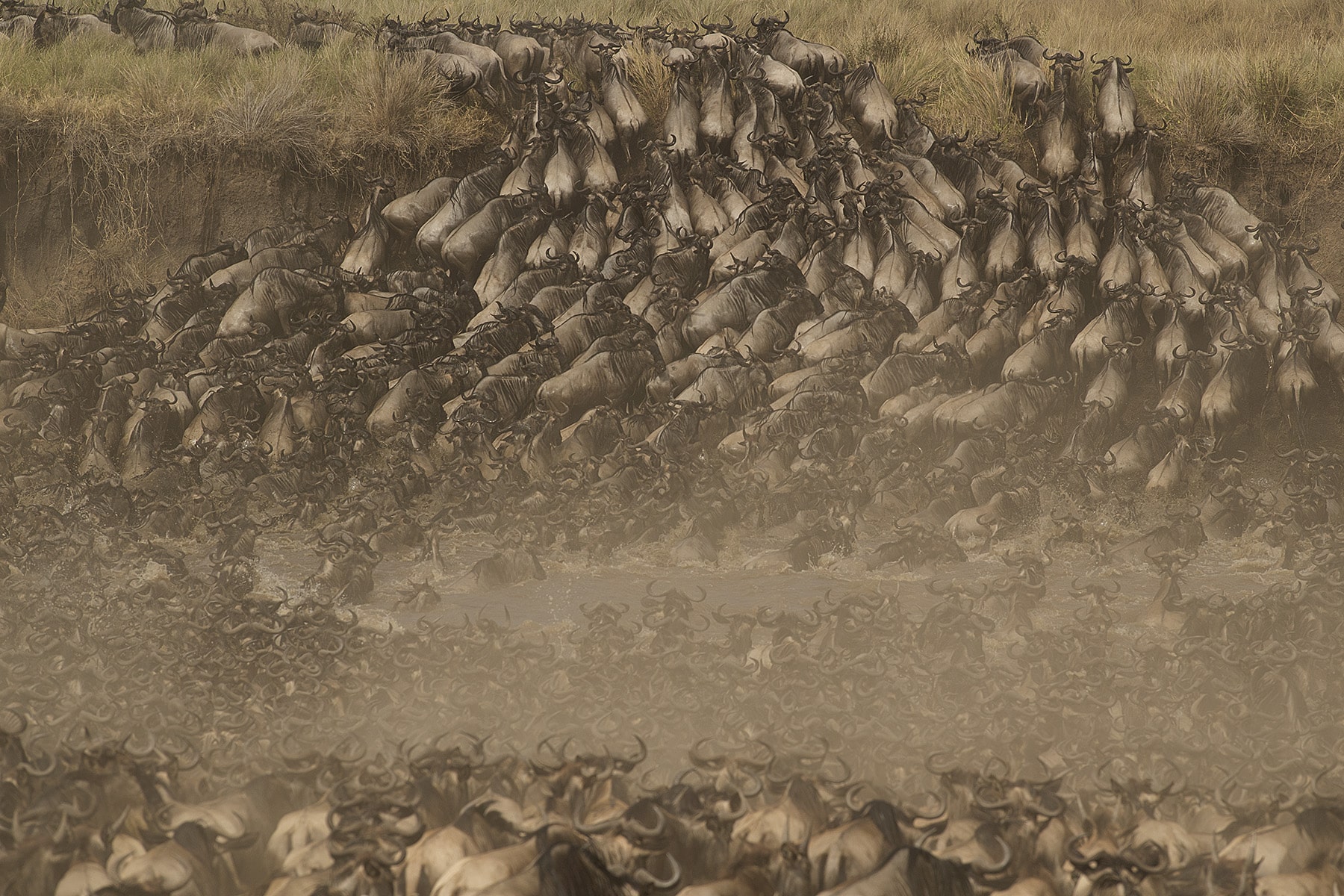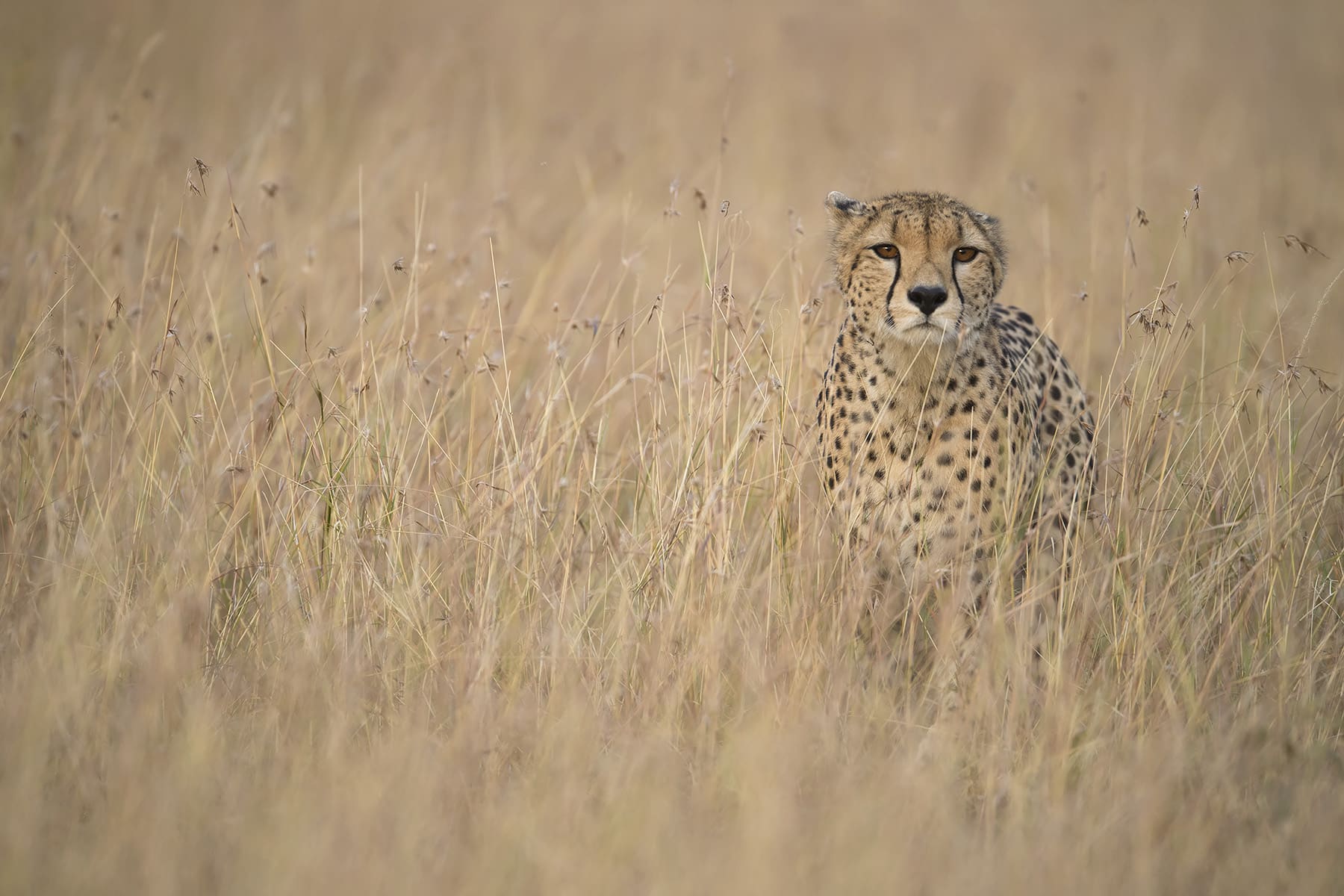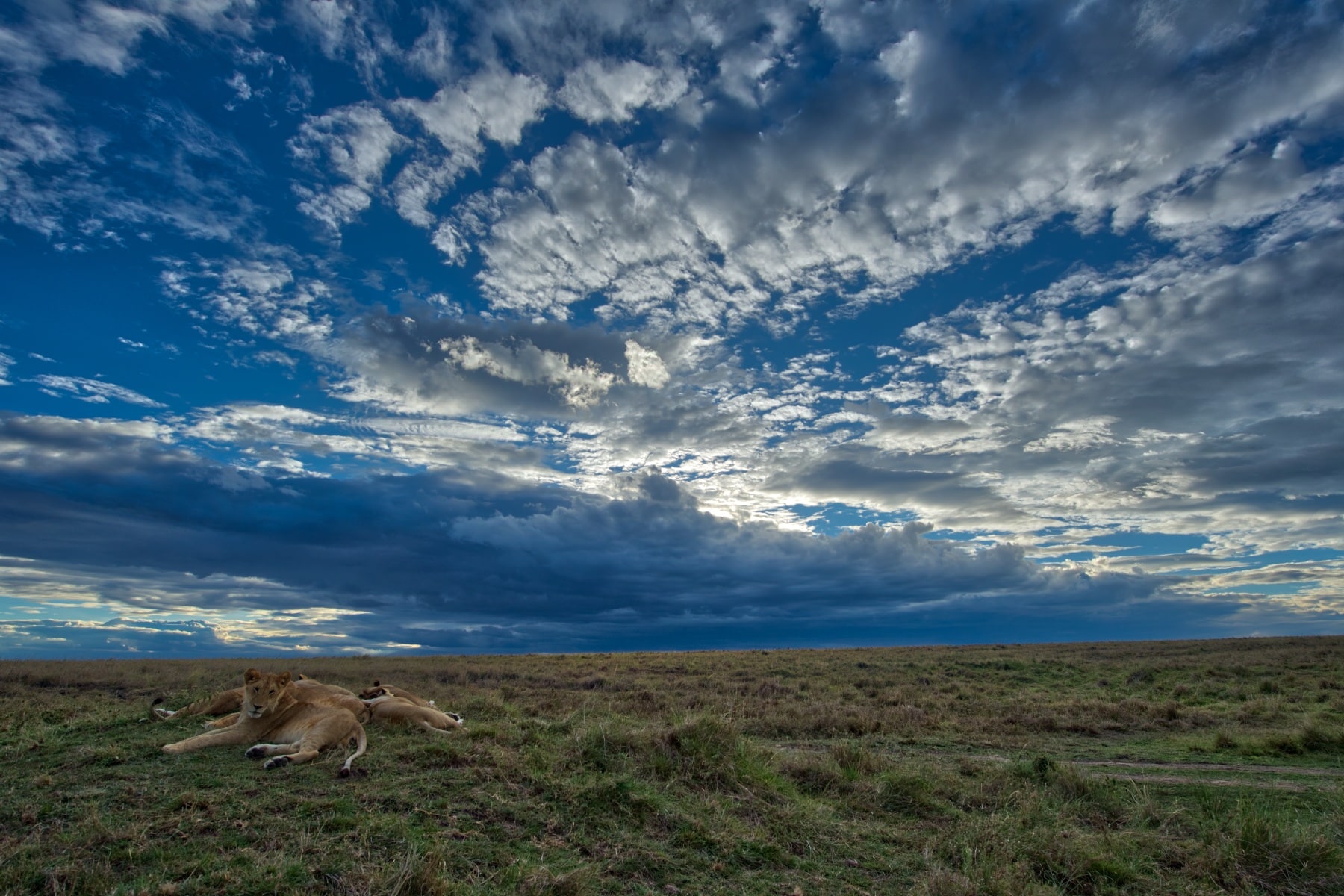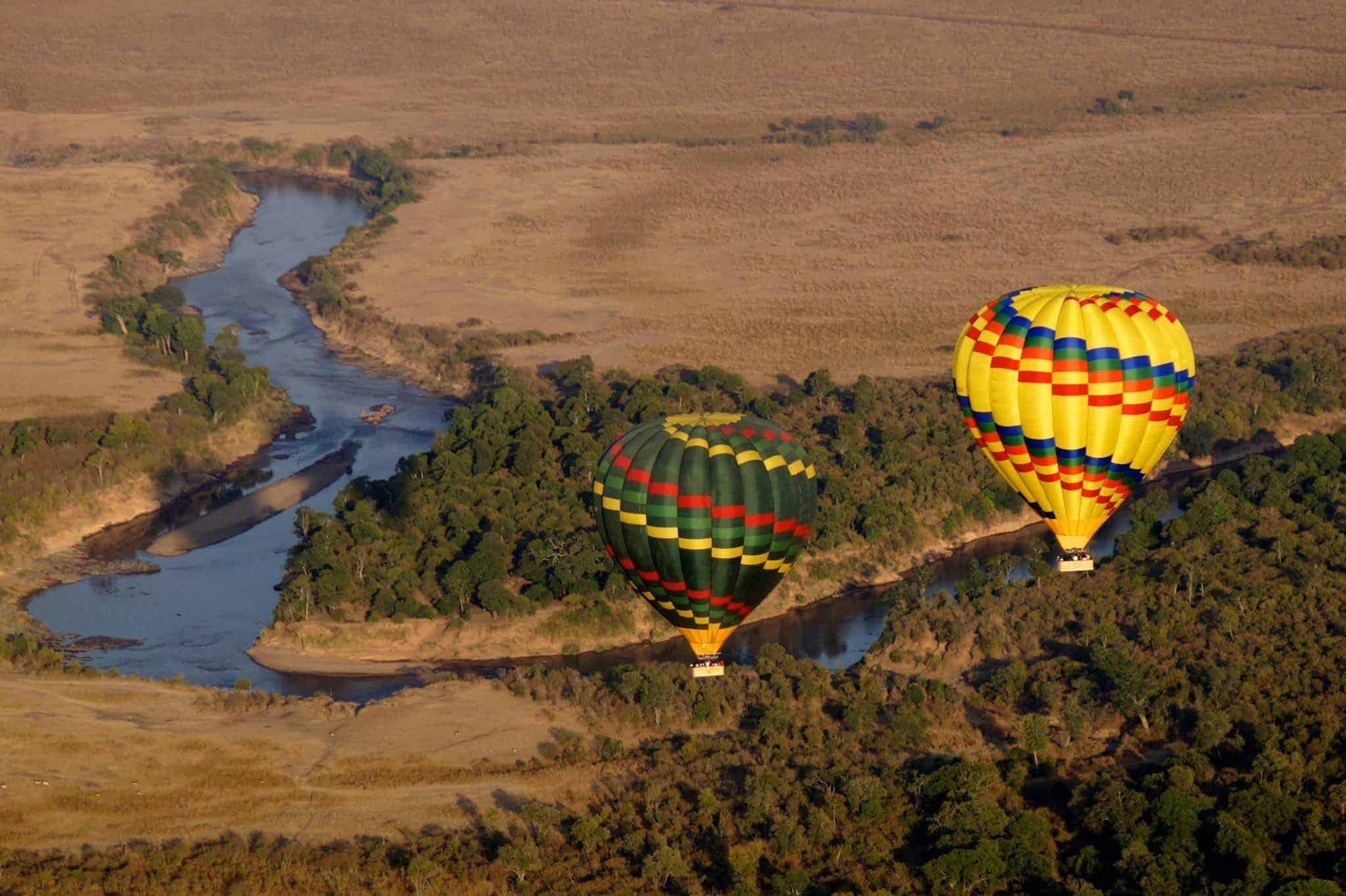About
Top Experiences
Type of Journey
Subscribe to newsletter and stay updated
Read about our travel expeditions, new destinations, new pictures, latest trip schedules
Kenya, renowned in East Africa, is celebrated for its expansive wildlife preserves and picturesque landscapes. The country’s protected areas showcase diverse biodiversity, with coastlines bordered by the Indian Ocean offering stunning Kenyan beaches adorned with white sands and turquoise waters. Among the standout experiences during a visit is relishing a Kenya migration safari, witnessing the awe-inspiring spectacle of the great migration in Masai Mara.
Every year, wildebeests migrate from Tanzania to Kenya’s Masai Mara in search of water and grazing ground. This journey spans more than 3000 kilometers and is an incredible spectacle of nature. Nature lovers would not want to miss out on this wonder of nature. A visit to Masai Mara will give you a fantastic wildlife experience. You will also feel the remarkable culture of the Maasai people. It is the best spot to see wild animals such as lions, leopards, cheetahs, elephants, rhinos, cape buffalos, giraffes, and zebras. Along with these, you will feel amazed by seeing the other mammals and birds.
To make your trip memorable, you should visit Lake Nakuru and Lake Naivasha. Lake Nakuru is diverse from Maasai Mara in its landscapes and wildlife. Here you can see Rothschild Giraffe, Flamingo birds, and Pelicans. The freshwater lake Naivasha is an attraction center for plenty of birds. It is a food shelter for residents and migratory birds. The key attraction of this place is the mighty fish eagle. The wildebeest migration in Masai Mara takes place from August to October.
Kenya’s topography and climate are reflected in its vegetation and animal life. The dense rainforest, swamps, extensive plains, mountain ranges, highlands, and other similar terrains act as natural habitats for various animals and birds.
The savannahs dotted with baobab and thorn trees provide classic African scenery. In the plains reside wildlife such as gazelles, zebras, wildebeest, and other hoofed animals. It is in Kenya where the Big Five African animals – lion, leopard, elephant, buffalo, and the endangered rhinoceros can be seen.
There are more than 1000 species of dynamic avifauna. These include migratory and endemic that are spotted in various regions of the country. Kenyan coastal towns and ports boast a rich culture and relaxing beaches.
Kenya has various wilderness areas which tourists can explore. The country has protected areas, national parks, conservancies, and reserves among many others. They support an extraordinary range of wildlife, perfect for an African safari.
One of the exclusive places to spot the best of Kenyan wildlife is in Maasai Mara. It calls travelers from every corner of the world to plan for an ideal Kenya migration safari. The wildebeest migration is a once-in-a-lifetime event that takes place in the Mara.
With experienced guides, comfortable accommodations, and multiple game drives, Wild Voyager offers the best of great migration tours for travelers. Your Kenya migration safari itinerary can also include exciting activities like hot air balloon rides, bush dinners, and local village interactions.
| Day 1 |
Landing at Nairobi On arrival at Nairobi airport, our representative will receive you and help you reach the hotel. Nairobi is the largest city in Kenya and the most cosmopolitan city in Eastern Africa. Contrary to the natural beauty found in other parts of the country, Nairobi has an urban core. You will be having an overnight stay in Nairobi. |
| Day 2 |
Drive to Lake Naivasha After having breakfast at the hotel, we will head to Lake Naivasha. The drive from the hotel to Naivasha will take around two and a half hours. Lake Naivasha is a freshwater lake and is a part of the Great Rift Valley. The lake is rich in biodiversity. Several bird species can be spotted here. After reaching Naivasha and having lunch, we will take you to Crescent Park. Crescent Park is to the east of Lake Naivasha. In Crescent Park, you can engage in activities like walking, hiking, and biking. You can spot wildebeest, zebras, and giraffes there. The lake is also home to hippos and birds like pelicans and saddle-billed storks. An hour-long boat ride on Lake Naivasha will be in the plan. Dinner and stay will be at Naivasha. |
| Day 3 |
Safari at Lake Nakuru After an early breakfast, we will take you for a game drive in Lake Nakuru. A lunch picnic will also be a part of the day's plan. Lake Nakuru National Park is one of Kenya's finest National Parks. It is flanked by wooded and bushy grasslands. Tourists will get a chance to enjoy the varied habitats and wide ecological diversity. It is home to hippos, black and white rhinos, lions, and the endangered Rothschild's giraffe. It is an ideal place for bird-watching, hiking, and picnics. You will return to Lake Naivasha by evening and relax at your hotel for the night. |
| Day 4 |
Drive to Masai Mara After breakfast at your hotel, we will take you to the Masai Mara. On the way, we will be visiting the Rift Valley. The camp where we are heading to is inside the park. We will have scheduled game rides to take you closer to the spots that are rich in wildlife. The Masai Mara is a witness to the Great Migration Kenya. The Wildebeest Migration Masai Mara is the largest migration of wildlife in the world. This is why it is hailed as the newest seventh wonder of the world. It cements its place as a must-visit wildlife reserve in the world. |
| Days 5 - 8 |
Safaris at Masai Mara Masai Mara is one of the most famous wildlife parks on this planet. It is a home for legendary documentaries such as the Big Cat Diaries. It is also known as the Mother of all National Parks. Here you can find various types of fauna along with more than 450 species of birds. Experiencing the Wildebeest migration Masai Mara is one of the best spectacles on Earth. These 4 days are mainly spent on game drive experiences. A well-trained guide cum driver will be present to guide you. Each day will cover different parts of the National Park and will have a distinct game drive in the morning, mid-morning, and afternoon. The plan to visit any area will depend upon the movement of animals. The guide will also keep track of the herds of wildebeests and the plethora of zebras on the banks. On one of these 4 days, a visit to the Masai village to interact with the locals will be in the plan. A balloon safari is also a part of the itinerary. The balloon safari is scheduled after the morning breakfast near the hippo pool. On the last day, you will experience a special bush dinner with Masai dances. We will also plan bonfires for you. |
| Day 9 |
Departure to Nairobi After your breakfast, you will be taken to the Nairobi Wilson airport, from where we will transfer you to the Jomo Kenyatta International airport so that you can proceed to your next destination or flight back home with fond memories of the trip. |
Get ready to experience a journey to the heart of nature’s most spectacular shows—the Great Migration Masai Mara—with Wild Voyager’s Kenya Migration Safari.
The wildebeest migration appears straight out of a movie but is real. This great migration, Masai Mara, includes more than 1.5 million wildebeests, joined by zebras, gazelles, impalas, and other plain animals. Together, they constantly travel between the Serengeti-Mara ecosystems. Masai Mara borders Serengeti in Tanzania. The animals begin their long, enduring journey from Serengeti, crossing various regions along the way. At the end of the year, they enter the Mara.
The journey for animals is not void of obstacles, most of them life-threatening. Crossing the crocodile-infested rivers and falling prey to hungry predators are the major challenges the animals face during the journey.
The migration occurs for a simple reason – pasture and water. Wherever there is the availability of nutritious grass and abundant water, the wildebeest heads there. However, there is no solid evidence to suggest how the wildebeest plan their routes. Although some experts do believe that wildebeests follow the weather and climate in general. Witnessing the Kenya migration safari is a breathtaking experience, as the wildebeest traverse vast landscapes in search of sustenance, creating an awe-inspiring spectacle for those lucky enough to witness this incredible journey.

Kenya is an amazing place for wildlife enthusiasts. It has diverse wildlife in its game parks, reserves, and places where animals are protected. Kenya offers beautiful landscapes and is a special spot for the Great Migration, an amazing journey that happens every year, and the Masai Mara National Reserve is a famous part of this journey, where you can sit up close and watch millions of wildebeests and zebras moving together.
But Kenya is not just about wildlife. It’s also about connecting with the Masai people, who have lived there for a long time. Witnessing the big five, like lions, elephants, buffaloes, leopards, and rhinos, will make your adventure even more exciting. Kenya takes care of its animals and nature, making it the best place for a safari. With its mix of land and water environments, including the famous Masai Mara National Reserve and Serengeti Plains, Kenya is a must-visit destination for any safari, including your Kenya Migration Safari and the Great Migration in the Masai Mara.
Timing is everything when it comes to experiencing the Great Migration of Masai Mara in its full glory. The best months to visit Masai Mara for an ideal Kenya migration safari is from July to October. During this time of year, the Mara is filled with epic scenes from the annual trek. One can also catch the popular river crossings during this period. Mara River crossings take travellers through a range of emotions on site.
These months also remain dry, which means less vegetation opens up possibilities for excellent game viewing. Due to the dry season, various wildlife species gather near watering holes to quench their thirst. Many accommodation choices, situated inside the reserve, are based near such watering holes to provide exclusive sightings of these animals. Although the migration’s timing varies, planning a visit from July to October increases the chances of witnessing this awe-inspiring natural spectacle.
Begin your journey with Wild Voyager into the heart of Kenya’s conservation efforts, where the magic of the Great Migration takes centre stage. As you start your Kenya migration safari, witness the collaborative endeavours of conservation organisations and local communities dedicated to safeguarding the natural wonders that define this extraordinary journey. This is not just a safari; it’s a commitment to preserving the legacy of the awe-inspiring migration and ensuring a sustainable future for Kenya’s wildlife.
The movement of migration is almost unpredictable and relies mostly on the climate. To provide a general overview, this timeline roughly explains how the wildebeest move. According to this, travelers can plan their Kenya migration safari.
Herds of wildebeest and other animals are typically spotted near Southern Serengeti. These months also mark the calving season. More than 100,000 calves are born every day. Unfortunately, these vulnerable newborn calves are not overlooked by predators. Dramatic chasings and kills are often seen during this season.
Adult as well as newborn wildebeest drift towards fresh grass near Central Serengeti. They are joined by thousands of zebras and antelopes. By May, wildebeest begin their mating season. The migration picks up pace and heads to Serengeti’s western corridor. The long rains occurring in May create heaving flooding and, at times, the migration becomes harder to spot.
The dry season occurs in June and large herds of animals prepare to pass a tough obstacle. They have to cross over the Grumeti River which is filled with hungry crocodiles. Many of the wildebeest lose their lives while trying to make it across alive.
Those who survive head north but another river crossing awaits them. This time it is the Mara River which has even deadlier Nile crocodiles. Wildebeest herds may hold back for hours or even days to cross the river. Crocodiles lie in wait to snatch up slower and vulnerable wildebeest and zebras.
Moreover, other predators waiting near the river bank such as lions and leopards always anticipate to ambush their prey. Crossings are major highlights of a Kenya migration safari as it appears like a film rolling in real-time.
However, the crossings are dependent solely on the timings of nature. Since they are not fixed, river crossing can be unpredictable.
Those herds who successfully survive, enter the beautiful Masai Mara. Mega herds of wildebeest, zebras, impalas, and other animals are seen sprawled in the reserve. They are attracted to Mara’s lush and abundant grass which offers ample grazing opportunities.
During these months, Masai Mara is filled with wildebeest, covering almost every inch of the reserve. During your Kenya migration safari, it is not unusual to spot these animals standing extremely close to safari vehicles.
One of the best ways to experience a luxury Kenyan migration safari is to stay in Mara’s private conservancies. They remain less crowded and provide relaxing game drives. Moreover, travelers can opt for other activities such as taking a hot air balloon ride. Watching wildebeest from the eagle’s eye while soaring up in the sky is an unforgettable sight.
When short rains begin, wildebeest begin to head back to Serengeti. They begin their calving season, ready to start their annual journey all over again.
In your Kenya Migration Safari, encounter the famous Big Five animals, learn about other notable species that call Kenya home, and explore the various ecosystems and habitats that create a unique tapestry of biodiversity.
Without a glimpse of the Big Five, no safari is complete. The five African species known as the “Big Five” are those that early big game hunters considered the most challenging and dangerous to hunt on foot in Africa. The African elephant, lion, leopard, Cape buffalo, and rhinoceros are the Big Five. Discover the fascinating details about these iconic creatures and experience a safari like no other.
Apart from the big five, one can also witness other species, from graceful giraffes to elusive cheetahs, Kenya is home to a plethora of wildlife. Get into the world of other notable species that share the landscapes with the Great Migration, adding to the charm of your Kenya migration safari.

Explore the diverse ecosystems and habitats that make Kenya a biodiversity hotspot. From the vast Serengeti Plains to the lush Maasai Mara National Reserve, each region contributes to the unique and thriving wildlife communities. These diverse ecosystems provide crucial sustenance for the migrating herds, creating a unique tapestry of life. It is within these habitats that the intricate dance of predator and prey, the rhythm of life and survival, plays out against the breathtaking scenery, ensuring a memorable chapter in your Kenya migration safari experience. Get ready to explore these diverse habitats and witness nature’s wonders up close!

Witness the dramatic and challenging Mara River Crossing, a pivotal moment in the Great Migration Masai Mara. Observe the herds facing challenging obstacles and predators as they navigate the risky waters, showcasing the resilience of nature.
A vast landscape of golden grass, stretching endlessly. This iconic landscape is the theatre of the Great Migration, where wildebeests, zebras, and gazelles create a natural spectacle. Predators lurk in the grass, making every moment a thrilling chapter in the circle of life. Your Kenya migration safari unfolds against this breathtaking backdrop, promising memorable encounters with wildlife and nature’s drama.
Masai Mara is a large national game reserve, measuring approximately 1,510 km2. It is named after the ancestral inhabitants of that area, the Masai people. The word Mara means ‘spotted’ in the local Masai language, referring to the short, bushy trees that cover the landscape.
The reserve is one of the major wildlife conservation and wilderness areas on the African continent. It is world-renowned for its healthy population of lions, cheetahs, leopards, and the African bush elephant. During your Kenya migration safari, you can also have the opportunity to come across the rare species of the park. These include black rhinos, servals, and wild dogs.
The popular BBC television show titled ‘Big Cat Diary’ was filmed in this reserve and followed the lives of the big cats of Mara. A naturalist and a photographer’s haven, Masai Mara mesmerises anyone. Whether you visit for the first or tenth time, the reserve surprises you with its splendid scenery, abundant wildlife, and rich local culture.
The great migration is one of the highlights of Masai Mara and is responsible for holding this migration every year.
When planning your Kenya migration safari with WildVoyager, we offer a diverse range of safari experiences that cater to every adventurer’s preferences. Our carefully curated itineraries ensure that you not only witness the Great Migration but also immerse yourself in the wonders of Kenya’s wildlife in various ways. Here are the types of safaris you can experience with WildVoyager:
When planning a journey with WildVoyager, one will have the opportunity to experience a diverse range of safaris that are curated to every individual’s taste. We curate itineraries to make sure that you not only witness the Great Migration of the Masai Mara but also engage in the wonders of Kenya’s wildlife in various ways. Here are some safaris that you can experience:
Balloon Safaris: This is best taken in Masai Mara. The ride soars above the Mara Plains. One can spot animals from a bird’s-eye view. Hot-air balloon rides create a special experience.

Walking Safaris: You can witness the wilderness on foot at a safe distance, led by our experts. It does not involve vehicles. One can observe minute details of the Mara. Guided walks offer a once-in-a-lifetime opportunity.
Family-Friendly Safaris: Create amazing memories with your loved ones on our family-friendly safaris. Curated to accommodate all ages. These safaris offer a blend of adventure, education, and excitement, ensuring a rewarding experience for every member of the family.
Luxury and budget-friendly safaris: Travel should not be compromised. Our safaris offer a variety of choices, from budget-friendly options to luxury. Experience the beauty of Kenya without maximising your budget, or treat yourself to a lavish escape with exclusive accommodations and personalised services.
No matter which type of safari you want, WildVoyager makes sure that the Kenya experience for everyone will be a transformative journey. Book with us today and unlock the door to an experience where nature reveals its incredible wonders.
Choosing the right accommodation for your journey is a vital aspect of your Kenya migration safari. Don’t worry; we are here to help you. Let our experts lead you through the best. From rustic bush camps to luxury lodges, we have everything for you according to your preference. WildVoyager will make sure that every night fits perfectly into your journey, making your safari adventure seamless and memorable.
Enhance your Kenya migration safari experience with our expert-guided tours and carefully curated packages. Have the maximum chance of witnessing the Great Migration and other wildlife while also getting insights from knowledgeable guides.
Our commitment to responsible tourism is woven into every aspect of our tour packages. Join us in supporting local conservation efforts and eco-friendly initiatives. From low-impact accommodations to ethical wildlife encounters, we strive to leave a positive impact on Kenya’s delicate ecosystem.
Before going on your Kenya migration safari, make sure you’re well-prepared with essential information and adhere to health and safety guidelines.
Pack smart before heading into the wild! Bring travel documents, health essentials, sturdy boots, and comfy clothes. Don’t forget your camera and binoculars. Prioritise safety with insect repellent, a basic first-aid kit, and medications. Pack sunglasses, a hat. and comfy shoes. Bring a reusable water bottle, snacks, a flashlight, and a power bank. Check the weather and add extras like a scarf or gloves. With a well-packed bag, you are ready to enjoy the wilderness and wildlife!
If you want to learn more, check out our blog, The Ultimate Packing Guide, for an in-depth look at preparing for your adventure.
Prioritise your well-being with health and safety guidelines for your Kenya migration safari. Reach out to our experts and stay informed about vaccinations, medical facilities, and general safety precautions to ensure a worry-free and fulfilling travel experience.
Begin your Kenya Migration Safari, a once-in-a-lifetime journey as you explore the wonders of the Great Migration, Masai Mara. Whether you’re a wildlife enthusiast, a photography buff, or a nature lover, this itinerary is your guide to creating lasting memories amidst the breathtaking landscapes and diverse wildlife of Kenya.
Combined Kenya and Tanzania’s great migration tours are popular and allow travelers to witness the flora and fauna of both countries. In Tanzania, guests can enjoy a thrilling Tanzania safari to the Ngorongoro crater and the Ndutu region.
Moreover, Serengeti National Park always offers exciting game drives. Lesser-known destinations like Lake Manyara are a key habitat for thousands of pink flamingos gathering on its shores along with other bird species.
Kenya migration safaris are not limited to bush experiences. Kenyan coastlines are famed worldwide. After finishing up game drives, it is not unusual to relax, spend time near the white sand beaches, and swim in Kenya’s pristine waters. Diani, Nyali, Lamu, Watamu, and Bamburi are just some of the beaches offering luxury and peace. Moreover, travelers can embark on boat rides and try numerous water activities to see Kenya’s marine life.